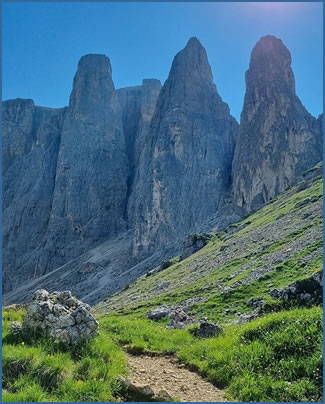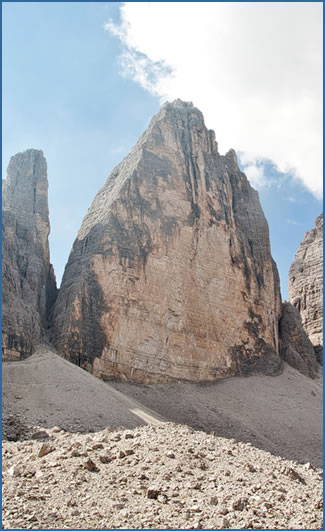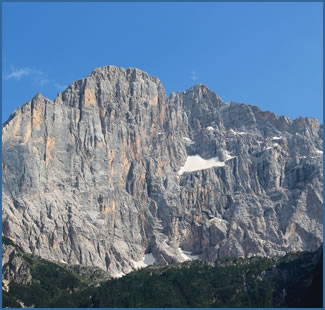Rock Climbing in the Dolomites
The Dolomites are a challenging and beautiful range of steep limestone peaks situated south of the Austrian/Italian border. Many of the peaks are over 3,000m+ high, providing excellent multi-pitch alpine routes, as well as long and demanding big wall routes up to 1,000m long. Some routes can be over 20-pitches long, however the vast majority of them can be done in a single day’s outing or with an overnight stay in a mountain hut or lodge.
The range and style of rock climbing routes that can be experienced in the Dolomites is unique and varies from:
- Single pitch sport routes
- Lots of moderate alpine multi-pitch routes with both trad and bolted options.
- Imposing big wall routes up to 1,000m long, including the north face of Cima Grande arguably one of the great north walls of the Alps.
- Via Ferrata routes
Buy various rock climbing guidebooks for the Dolomites from our shop.
These include guidebooks for long multi-pitch rock routes, sport routes and Via Ferratas routes.
The Dolomites are particularly appealing to the pure rock climber for the following reasons when compared to their western Alps neighbours:
- Impressive vertical limestone rock rising out of Alpine meadows
- Relatively short walk-ins from the road to the base of the climb - this can be typically less than an hour or by using cable cars.
- Majority of the routes can be climbed in a single day, reducing the amount of kit to be carried on the route, or are easily accessible from mountain huts.
- No ice fields or glaciers to cross to access the routes.
All of this along with its abundance and variety of rock faces makes the Dolomites one of the best places to go mountain rock climbing in the world.
Rock climbing in the Dolomites is defined by iconic limestone spires and towers that dominate the landscape. The area is vast stretching some 50 miles (80Kms) east of Bolzano, which is split into different groups linked by a good road network making it easy to visit several of these areas in one trip. Some of the classic areas are as follows.
Map of the classic rock climbing areas in the Dolomites

Catinaccio and the Vajolet Towers
The Catinaccio Group is home to the famous Vajolet Towers, a legendary climbing destination, offering classic alpine routes on dramatic limestone spires. A group of 3 spires, with the most famous being Torre Delago. These towers offer superb, exposed climbing at surprisingly amenable grades, with routes up to 150m long.
The main face of Cime Catinaccio provides the “big wall experience” with routes up to 600m long.
A selection of the best routes can be found in The Dolomites – Rock Climbs and Via Ferrata Guidebook by Rockfax.

Sella Towers and Piz Ciavazes
The Sella Towers and Piz Ciavazes offer some of the most iconic and accessible alpine rock climbing in the Dolomites, with many classic mid-length trad multi-pitch routes.
The Sella Towers are a group of 4 limestone spires perched above the Sella Pass. They are renowned for their short approaches, sunny faces, and routes suitable for all levels. easy descents, and well-protected routes that are not too long. Piz Ciavazes is a massive cliff face just east of the Sella Towers, known for its longer, more committing multi-pitch climbs.
On the other side of the Sella Pass is the mighty northwest face of Sasso Pordoi, arguably one of the largest and most impressive in the Dolomites, with routes up to 800m long. These routes are a much more serious undertaking and have an "alpine" experience about them.
Sella Rock is a selective guidebook describing 255 classic and sport routes in the Sella Group, including the Sella Towers, Piz Ciavazes and Sasso Pordoi.

Falzarego Pass
Between Cortina and St Kassian is the Falzarego Pass that offers a diverse climbing experience, from beginner-friendly sport routes to historic via ferratas and trad multi-pitch climbs on the famous Falzarego Towers. With some of the best routes in the Dolomites, there are plenty of south-facing mid-grade routes; with short easy approaches; uncomplicated descents; and solid, well-protected routes.
A selection of the best routes for the Falzarego Pass can be found in The Dolomites – Rock Climbs and Via Ferrata Guidebook by Rockfax.
Marmolada
The highest mountain in the Dolomites is Marmolada, with its impressive 800m high and 3km wide south facing limestone wall. This south face of Marmolada is legendary among climbers and mountaineers with its vast limestone wall hosting over 200 multi-pitch routes, many of which are considered masterpieces of alpine climbing.
All the routes on this south face are long and serious, and unique to the Dolomites, may take longer than a day to complete. Hence it is wise to pack a bivouac bag. Unless you catch the expensive last cable car from the summit then the descent is down the north side of the mountain, which has the only glacier in the region! It is therefore recommended that in-step crampons and lightweight boots be worn.

The Marmolada rock climbing guidebook – South Face, is the definitive guidebook describing 192 multi-pitch routes on Marmolada’s south face.
Tre Cime
An iconic symbol of the Dolomites, the Tre Cime group (comprising Cima Grande, Cima Ovest, and Cima Piccola) are world famous in the climbing community. These 3 towers defined by their steep, exposed limestone faces, and historic alpine routes.
The north face of Cima Grande is one of the great alpine north faces and is breathtakingly steep - a real big wall. The classic route is called Via Comici-Dimai, and is 450m and 18-pitches long. Graded at UIAA V11+ (UK E2 5c or F6b) it is very sustained for long periods and therefore demands the prestige attached to it. However as with many of the routes in the Dolomites it is possible to aid across the difficult sections, which reduces this route to V1/A1 (UK E1 5b or F6a).
A selection of the best routes for Tre Cime can be found in The Dolomites – Rock Climbs and Via Ferrata Guidebook by Rockfax.

Civetta
At around 4km long, the north-west face of Civetta is considered one of the most impressive and recognized features of the Dolomites, a 1,000m high cliff that dominates the Alleghe valley. For climbers it is renown as the “wall of walls” offering adventurous alpine multi-pitch routes, where the experience of using trad gear is essential. These routes are between 400m and 1,000m long, and are often characterized by featured walls veined by vertical cracks, corners and chimneys.
The Civetta North-West Face Rock Climbing Guidebook is a selective guidebook covering 78 of the best long alpine multi-pitch routes on the north-west face of Civetta.

Single pitch sport routes
The Dolomites are not all about long multi-pitch routes as there are also many single-pitch sport routes, especially around Cortina and Cadore. The Cortina Sport Climbing Guidebook covers 28 crags and over 1,000 mainly single pitch sport routes.
The Dolomites - Rock Climbing Logistics
There are numerous different rock climbing guidebooks covering the Dolomites that can be bought from our shop. Some of the selective guidebooks are:
- The Dolomites – Rock Climbs and Via Ferrata by Rockfax
- Dolomiti New Age by Versante Sud
- Dolomites Sport Climbing Crags by Versante Sud
- Dolomites Hard Rock by Versante Sud
- The Alpen en Bloc 2 guidebook covers 12 bouldering areas to the north and east of Bolzano in the Dolomites.
Buy these various rock climbing guidebooks for the Dolomites that are all in English text from our shop.
The best time of the year to visit the Dolomites for rock climbing is the summer months of July through to September. However it is not possible to guarantee good weather during this time - after all this is still the Alps! During prolonged periods of bad weather it is possible to escape to the superb rock climbing area at Arco which is only a 2.5 hour drive away.
With regards to equipment it is sensible to bring duel ropes if you are going to attempt some of the longer routes. Though a lot of the routes are bolted it is advisable to bring a full rack of nuts and cams.
The nearest international airports are Venice and Verona in Italy or Munich and Salzburg to the north. As the Dolomites area is vast, it is advisable to hire a car in order to easily travel around the different areas.
